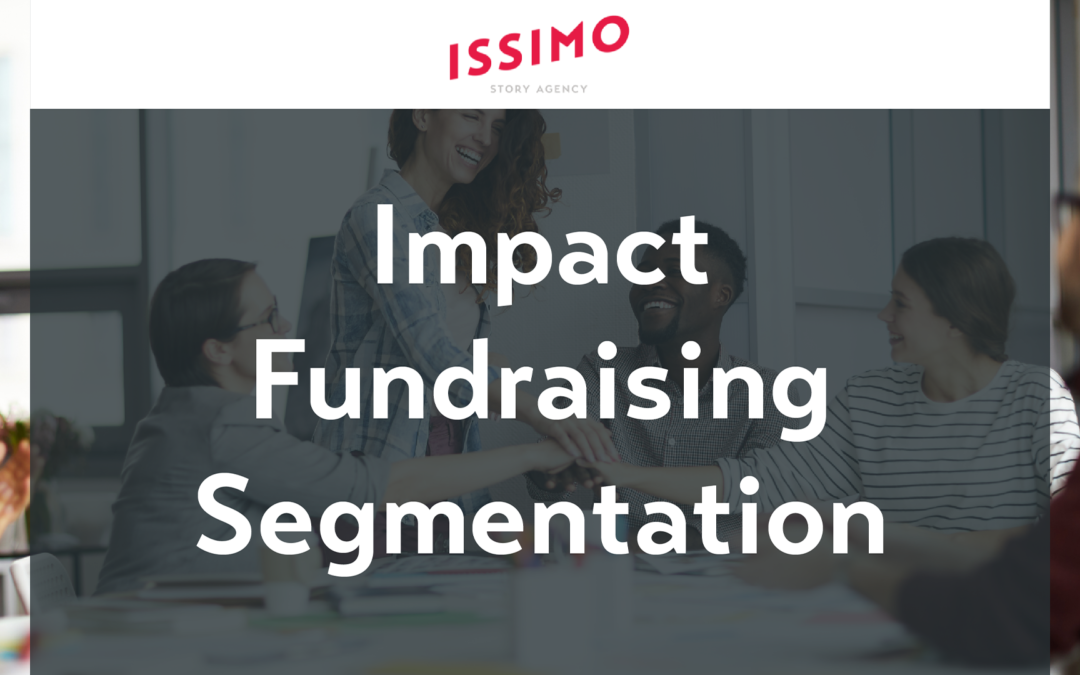Segments of Impact Fundraisers
There are three types of impact fundraisers. Knowing which one you most closely relate to can help you succeed moving forward.
Impact fundraising has always had its challenges, which were made even greater by a global pandemic. At ISSIMO Story Agency, we wanted to better understand what is working in fundraising for impact. What are the best practices and how can marketing leaders within these organizations drive better fundraising results?
We recently conducted an attitudinal research study with respondents across 34 countries and 159 organizations around the globe to better understand what is working in regard to impact fundraising.
While all the respondents were involved with fundraising for impact, it was eye-opening to see how their perspectives, activities and success levels differed among them in the research.
Different Attitudinal Segments, Different Levels of Success
Three distinct segments emerged from the data – three different types of impact fundraisers. Which one resonates with your situation?
#1: Confident Respondents
These respondents say their organizations are very good at fundraising. Because they are considered thought leaders in their space, they do a good job at telling their story and have the resources they need to reach investors in a compelling way.
#2: Aspiring Respondents
These respondents say their organization is less likely to be consistent about reflecting their brand story. However, they are just as likely as Confident respondents to say their organization is considered a thought leader, and therefore, much more likely than the other segments to believe in the benefits of compelling, consistent storytelling and thought leadership. They believe mission-driven investing is more popular than ever, and that it’s important to invest in marketing to engage investors.
#3: Struggling Respondents
Struggling respondents see large gaps between where their organizations are and where they should be in regards to fundraising—more than the Confident and Aspiring segments. They say their marketing is much less impactful than it should be because they rely on old-fashioned fundraising approaches. They also recognize that they have a lot to learn about thought leadership.
Each of these three segments encompass all age groups, genders and leadership levels across a wide range of organizational revenue sources, investment approaches, fundraising targets and marketing budgets. In fact, their marketing budgets ranged from $25,000 to over $1 million.
Going into the research study, we expected to see more of an attitudinal difference based on an organization’s size, and specifically that larger firms would have more resources. But the data didn’t support this as there was a pretty even firm size distribution across all three attitudinal segments.
Which Segment Does Your Organization Fall in?
How can you tell which segment you and your organization are most aligned with? And what good does that do to know? Thinking about this impact fundraising research, here are some shortcuts to help you identify where your organization falls. Would you rate your organization as low, medium or high on the following characteristics:
- Internal message alignment
- External message clarity
- Adaptability of approaches
If you find yourself in the Confident group, congratulations! You have a high sense of message alignment within your organization as well as clarity with stakeholders outside your team. You are adaptable when it comes to fundraising approaches and are open to new ideas. But this only represents about 30 percent of the market. The remaining group has some room for improvement in order to get better fundraising results.
The good news is that the data suggests several things you and your organization can do to amplify your fundraising efforts.
The Secret Sauce for Successful Fundraising
This impact fundraising research also revealed two striking elements associated with fundraising success (or lack thereof).
Impact Objective
One factor that differentiates the Confident, Aspiring, and Struggling groups is the extent to which their organizations understand the commitment to their impact objective among internal and external stakeholders. Check out these statistics about Confident respondents:
- 73 percent of leader’s say they have a crystal clear understanding of their organization’s impact objective
- 45 percent say others in their team share the same understanding
- 82 percent say investors and other stakeholders outside the organization have at least a fairly good understanding of the organization’s impact objective
When it comes to understanding their organization’s impact objective, the level of internal understanding beyond their leadership team, and how investors and outside stakeholders view the impact objective, the research shows Aspiring and Struggling respondents have much lower levels than those in the Confident group. However, both of these groups are far less likely than Confident respondents to say everyone in their organization clearly understands their brand mission and vision.
“If confuse, you lose.” — Donald Miller
The data reinforces this adage. In most organizations, there’s a precipitous drop off from executives to the broader team to external stakeholders. Imagine you’re the fundraising leader at the center of a bullseye. You understand the mission and the impact objective. You know the story and the why. As you step out to the next ring, from inside your head to inside your team, the clarity drops by half. And it’s cut in half again as you go from your team to outside your organization. We call this the clarity decay curve.
It’s like the telephone game; the message gets muddled the further it goes from the source. And the more things become unclear, the more we slow down, the more fear shows up, and the more we close up.
How do you fix this? You need to make your story concrete—not just in the conversations you have but in things that will preserve the clarity of your story to an audience. Write it out in a manifesto. Make a film. Make a picture book—whatever fits your team. Keep it simple by focusing on the key elements of your story. Ask yourself these questions:
- Whom do you serve?
- What do they want and what is preventing them from getting it?
- How are you uniquely able to remove that obstacle for them?
- Once you have a clear message, share it consistently.
Brand Story Consistency
Another difference between the three segments is their level of consistency in telling their brand story.
Confident respondents are significantly more likely to say that everyone in their organization clearly understands their brand mission and vision, that everyone agrees on what their brand story is, and that their organization reflects their brand story consistently across all touchpoints with potential investors.
Although Aspiring respondents say they’re least likely to feel their organization has a lot to learn when it comes to marketing or fundraising, there is a lack of clarity about their brand story. They agree that telling a consistent story about their organization would make their fundraising efforts more effective. But only 26 percent of their organization agrees what that brand story is.
While Struggling respondents are slightly more likely than Aspiring respondents to say everyone within their organization agrees on what their brand story is, they are significantly more likely to say that different people in their organization have different versions on what the mission and vision is when speaking with potential investors. In fact, 46 percent agree with this statement, which is double the rate of Confident and Aspiring respondents. 84 percent of struggling respondents agree that their organization has a lot to learn about marketing.
The Impact on Investor Perception
When members within your organization don’t clearly know the objective, mission and vision, or your organization doesn’t have brand story consistency, there’s a huge impact on investor perception.
Confident respondents who say they do a good job of marketing and fundraising have a shared understanding of the brand story both internally and externally and consistently deliver that story across all touchpoints, gaining higher visibility and credibility among potential investors. 69 percent say they strongly agree that their organization is considered a thought leader and 75 percent say that their founder or leader is considered a thought leader.
Aspiring respondents say they know how to market and fundraise effectively but their inability to agree on a brand story hampers their ability to deliver it consistently and in a compelling way.
Struggling respondents not only suffer from a lack of consistent story messaging to investors, they also admit they don’t communicate their story well in marketing.
The Impact of Effective Storytelling
The most powerful way to get your brand’s story across is through visual storytelling. It’s a place where your message meets emotion. Although 87 percent of all respondents say their organizations use visual storytelling as part of their fundraising efforts, each segment rates its effectiveness differently. Case and point, here’s the breakdown of who would say their visual storytelling elements are excellent or very good when trying to fundraise:
- 76 percent of Confident respondents
- 51 percent of Aspiring respondents
- 62 percent of Struggling respondents say their visual storytelling elements are OK or even poor.
The big takeaway here? Combining clarity, a shared understanding of your brand story, and consistency among all touchpoints is the key to investor loyalty and fundraising success.
Now ask yourself: Are you a Confident, Aspiring or Struggling impact fundraiser?
Regardless of where you find yourself today, you take some data-driven steps to improve your capabilities by having a clear story and sharing it consistently and effectively with all stakeholders.
To learn more about each segments’ behaviors and the opportunities they present, check out our entire executive summary. And to explore the data yourself, check it out here.

